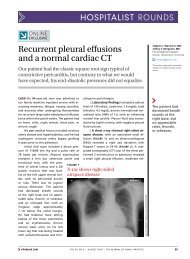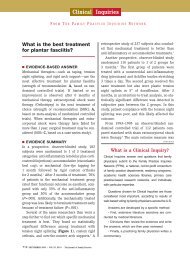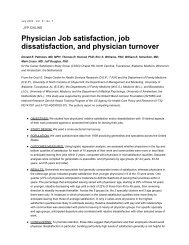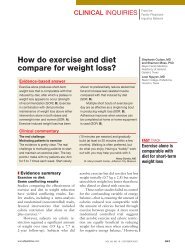PURLs® - The Journal of Family Practice
PURLs® - The Journal of Family Practice
PURLs® - The Journal of Family Practice
Create successful ePaper yourself
Turn your PDF publications into a flip-book with our unique Google optimized e-Paper software.
IllustratIve case<br />
A 68-year-old man with a history <strong>of</strong> ulcer<br />
disease and mild renal insufficiency comes<br />
to your <strong>of</strong>fice complaining <strong>of</strong> severe pain<br />
in his right foot. You note swelling and<br />
redness around the base <strong>of</strong> the big toe<br />
and diagnose acute gout. Wishing to avoid<br />
nonsteroidal anti-inflammatory drugs<br />
www.jfponline.com<br />
PURLs ®<br />
Acute gout: Oral steroids<br />
work as well as NSAIDs<br />
Prednisone is a safe and effective alternative when<br />
NSAIDs are contraindicated<br />
Use a short course <strong>of</strong> oral<br />
steroids (prednisone 30-40<br />
mg/d for 5 days) for treatment<br />
<strong>of</strong> acute gout when nonsteroidal<br />
anti-inflammatory drugs<br />
(NSAIDs) are contraindicated.<br />
Steroids are also a reasonable<br />
choice as first-line treatment. 1,2<br />
<strong>Practice</strong> changer<br />
Strength <strong>of</strong> recommendation<br />
B: 2 good-quality, randomized controlled trials (rcts)<br />
Janssens HJ, Janssen M, van de lisdonk eH,<br />
van riel Pl, van Weel c. Use <strong>of</strong> oral prednisolone<br />
or naproxen for the treatment <strong>of</strong> gout arthritis: a<br />
double-blind, randomized equivalence trial.<br />
Lancet. 2008;371:1854-1860.<br />
Man cY, cheung It, cameron PA, rainer tH.<br />
comparison <strong>of</strong> oral prednisolone/paracetamol<br />
and oral indomethacin/paracetamol combination<br />
therapy in the treatment <strong>of</strong> acute goutlike arthritis:<br />
a double-blind, randomized, controlled trial. Ann<br />
Emerg Med. 2007;49:670-677.<br />
(NSAIDs) and colchicine because <strong>of</strong> the<br />
patient’s medical history, you wonder what<br />
you can safely prescribe for pain relief.<br />
NSAIDs have become the mainstay<br />
<strong>of</strong> treatment for acute gout, 3,4 replacing<br />
colchicine—widely used<br />
for gout pain relief since the early 19th century.<br />
5 Colchicine fell out <strong>of</strong> favor because it<br />
routinely causes diarrhea and requires caution<br />
in patients with renal insufficiency. 6<br />
Now, however, there is growing concern<br />
about the adverse effects <strong>of</strong> NSAIDs.<br />
z Comorbidities, age,<br />
mean fewer options<br />
NSAIDs increase the risk <strong>of</strong> gastrointestinal<br />
(GI) bleeding, especially in the first<br />
week <strong>of</strong> use. 7 Cyclooxygenase-2 (COX-2)<br />
inhibitors, considered as effective as<br />
NSAIDs in treating acute gout pain, 8 are<br />
also associated with GI bleeds. 9 In addition,<br />
NSAIDs and COX-2 inhibitors<br />
increase cardiovascular risks, prompting<br />
the American Heart Association<br />
to recommend restricted use <strong>of</strong> both. 10<br />
NSAIDs’ effect on renal function, fluid<br />
retention, and interactions with anticoagulants<br />
are additional concerns, because<br />
gout patients are generally older and <strong>of</strong>ten<br />
have comorbid renal and cardiovascular<br />
diseases. 3,11-13<br />
Priority Updates from the Research<br />
Literature from the <strong>Family</strong> Physicians<br />
Inquiries Network<br />
c o N t I N U e D<br />
shailendra Prasad,<br />
MBBs, MPH<br />
Department <strong>of</strong> <strong>Family</strong> Medicine<br />
and Community Health,<br />
University <strong>of</strong> Minnesota,<br />
Minneapolis<br />
Bernard Ewigman,<br />
MD, MsPH<br />
Department <strong>of</strong> <strong>Family</strong> Medicine<br />
<strong>The</strong> University <strong>of</strong> Chicago<br />
P U R L s E D i t o R<br />
John Hickner, MD, Msc<br />
Department <strong>of</strong> <strong>Family</strong> Medicine<br />
<strong>The</strong> University <strong>of</strong> Chicago<br />
PURLs ®<br />
iNstaNt PoLL<br />
Do you routinely<br />
prescribe prednisone<br />
(or other oral steroids)<br />
for acute gout?<br />
q Yes, but only when<br />
other treatments<br />
are contraindicated.<br />
q Yes, it’s my preferred<br />
treatment.<br />
q No, I have never<br />
prescribed oral steroids<br />
for acute gout.<br />
Go to www.jfponline.com<br />
and take our Instant Poll!<br />
vol 57, No 10 / october 2008 655
PURLs ®<br />
fast track<br />
Although prednisone<br />
is prescribed for<br />
gout only 9% <strong>of</strong><br />
the time, evidence<br />
suggests it’s a<br />
good alternative<br />
to NSAIDs<br />
PURLs methodology<br />
This study was selected and<br />
evaluated using FPIN’s Priority<br />
Updates from the Research<br />
Literature (PURL) Surveillance<br />
System methodology. <strong>The</strong><br />
criteria and findings leading to<br />
the selection <strong>of</strong> this study as<br />
a PURL can be accessed at<br />
www.jfponline.com/purls.<br />
In the United States, nearly 70% <strong>of</strong><br />
patients who develop acute gout seek<br />
treatment from primary care physicians. 12<br />
<strong>Family</strong> physicians need a safe alternative<br />
to NSAIDs to relieve the severe pain associated<br />
with this condition. Will oral<br />
corticosteroids fit the bill?<br />
stuDy summarIes<br />
z Oral steroids: A safe<br />
and effective alternative<br />
Janssens et al 1 conducted a double-blind,<br />
randomized equivalence trial <strong>of</strong> 118 patients<br />
to compare the efficacy <strong>of</strong> prednisolone<br />
and naproxen for the treatment <strong>of</strong><br />
monoarticular gout, confirmed by crystal<br />
analysis <strong>of</strong> synovial fluid. <strong>The</strong> study was<br />
conducted in the eastern Netherlands at<br />
a trial center patients were referred to by<br />
their family physicians. Those with major<br />
comorbidities, including a history <strong>of</strong> GI<br />
bleed or peptic ulcer, were excluded.<br />
Participants were randomized to<br />
receive either prednisolone 35 mg* or<br />
naproxen 500 mg twice a day, with lookalike<br />
placebo tablets <strong>of</strong> the alternate<br />
drug, for 5 days. Pain, the primary outcome,<br />
was scored on a validated visual<br />
analog scale from 0 mm (no pain) to 100<br />
mm (worst pain experienced). 15 <strong>The</strong> reduction<br />
in the pain score at 90 hours was<br />
similar in both groups. Only a few minor<br />
side effects were reported in both groups,<br />
and all completely resolved in 3 weeks.<br />
<strong>The</strong> study by Man et al 2 was a randomized<br />
trial that compared indomethacin<br />
with oral prednisolone in 90 patients<br />
presenting to an emergency department in<br />
Hong Kong. Diagnosis <strong>of</strong> gout was made<br />
by clinical impression. Participants in the<br />
indomethacin group also received an intramuscular<br />
(IM) injection <strong>of</strong> dicl<strong>of</strong>enac<br />
75 mg, and those in both groups were<br />
monitored for acetaminophen use as a<br />
secondary endpoint.<br />
*Prednisone is the precursor <strong>of</strong> prednisolone and is<br />
activated in the liver. the activity <strong>of</strong> both drugs is<br />
comparable, and prednisone and prednisolone can be<br />
converted milligram to milligram. However, prednisolone<br />
may be preferred for patients with severe liver disease. 14<br />
(In the United States, prednisolone is available as a<br />
liquid and prednisone as a tablet.)<br />
656 vol 57, No 10 / october 2008 the <strong>Journal</strong> <strong>of</strong> famIly PractIce<br />
Pain reduction, the primary endpoint,<br />
was assessed with a 10-point visual analog<br />
score, and was slightly better statistically<br />
in the oral steroid group. <strong>The</strong> study<br />
was not designed to evaluate for safety,<br />
but the authors noted that patients in the<br />
indomethacin group experienced more<br />
adverse effects (number needed to harm<br />
[NNH] for any adverse event: 3; NNH<br />
for serious events: 6).<br />
Short-term steroids have few side effects<br />
In both studies, patients receiving oral<br />
steroids experienced no significant side effects.<br />
This finding is consistent with other<br />
studies that have investigated short-term<br />
oral steroid use in the treatment <strong>of</strong> both<br />
rheumatoid arthritis and asthma. 16,17<br />
What’s neW?<br />
z Evidence supports use<br />
<strong>of</strong> steroids for acute gout<br />
In the United States, prednisone is prescribed<br />
as treatment for acute gout only<br />
about 9% <strong>of</strong> the time. 12 <strong>The</strong>se 2 studies—the<br />
first randomized trials comparing<br />
oral steroids with NSAIDs, the usual<br />
gout treatment—may lead to greater use<br />
<strong>of</strong> steroids for this painful condition.<br />
Both studies were well designed and<br />
conducted in an outpatient (or emergency)<br />
setting. Both showed that a short<br />
course <strong>of</strong> oral steroids is as effective as<br />
NSAIDs, and without significant side<br />
effects.<br />
Previous studies have compared IM<br />
steroids with NSAIDs, and IM steroids<br />
with IM adrenocorticotropic hormone<br />
(ACTH). 18,19 However, these studies were<br />
not blinded—just one <strong>of</strong> their methodological<br />
problems. 4<br />
caveats<br />
z Joint aspiration<br />
is not the norm<br />
In the Janssens study, participants were<br />
diagnosed with gout after monosodium<br />
urate crystals were found in joint aspirate.<br />
1 This may not be the usual practice<br />
in primary care settings, where a clinical<br />
diagnosis <strong>of</strong> gout is typically made. <strong>The</strong>
authors indicate that the failure to perform<br />
joint aspiration will lead to occasional<br />
cases <strong>of</strong> septic arthritis being treated with<br />
oral steroids. We recommend joint aspiration<br />
or a referral for such a procedure<br />
when clinical evidence (eg, fever and leukocytosis)<br />
is suggestive <strong>of</strong> septic arthritis.<br />
z Possible impact<br />
<strong>of</strong> acetaminophen<br />
In the study by Man et al, acetaminophen<br />
was used by both groups as an<br />
adjunct for pain relief, and the amount<br />
used was higher (mean 10.3 g vs 6.4 g<br />
over 14 days) in the oral steroid group.<br />
It is possible that some <strong>of</strong> the pain relief<br />
experienced by those in the steroid<br />
group may have been from acetaminophen;<br />
however, a difference <strong>of</strong> 4 g over a<br />
14-day period makes that unlikely. Even<br />
if additional acetaminophen is required,<br />
the advantages <strong>of</strong> oral steroids rather<br />
than NSAIDs or colchicine for patients<br />
with contraindications remain.<br />
Also <strong>of</strong> note: <strong>The</strong>se trials examined<br />
short-term treatment <strong>of</strong> acute gout. <strong>The</strong>se<br />
findings cannot be extrapolated to the<br />
treatment <strong>of</strong> intercurrent gout or chronic<br />
gouty arthritis, since long-term steroid<br />
use has severe adverse effects.<br />
challenGes to ImPlementatIon<br />
z No significant barriers<br />
We found little to prevent physicians<br />
from adopting this practice changer. Oral<br />
steroids are readily available and inexpensive,<br />
and most primary care clinicians<br />
regularly prescribe them for other conditions.<br />
This practice change recommendation<br />
should be readily implemented. n<br />
the PUrls Surveillance System is supported in part by<br />
Grant Number Ul1rr024999 from the National center<br />
For research resources, a clinical translational Science<br />
Award to the University <strong>of</strong> chicago. the content is solely<br />
the responsibility <strong>of</strong> the authors and does not necessarily<br />
represent the <strong>of</strong>ficial views <strong>of</strong> the National center For<br />
research resources or the National Institutes <strong>of</strong> Health.<br />
references<br />
1. Janssens HJ, Janssen M, van de lisdonk eH, van<br />
riel Pl, van Weel c. Use <strong>of</strong> oral prednisolone or<br />
naproxen for the treatment <strong>of</strong> gout arthritis: a double-blind,<br />
randomised equivalence trial. Lancet.<br />
2008;371:1854-1860.<br />
www.jfponline.com<br />
acute gout: oral steroids work as well as NsaiDs<br />
2. Man cY, cheung It, cameron PA, rainer tH. comparison<br />
<strong>of</strong> oral prednisolone/paracetamol and oral<br />
indomethacin/paracetamol combination therapy in<br />
the treatment <strong>of</strong> acute goutlike arthritis: a doubleblind,<br />
randomized, controlled trial. Ann Emerg Med.<br />
2007;49:670-677.<br />
3. Sutaria S, Katbamna r, Underwood M. effectiveness<br />
<strong>of</strong> interventions for the treatment <strong>of</strong> acute and<br />
prevention <strong>of</strong> recurrent gout—a systematic review.<br />
Rheumatology. 2006;45:1422-1431.<br />
4. Janssens HJ, lucassen Pl, van de laar FA, Janssen<br />
M, van de lisdonk eH. Systemic corticosteroids<br />
for acute gout. Cochrane Database Syst Rev.<br />
2008;(2):cD005521.<br />
5. Weinberger A, Pinkhas J. the history <strong>of</strong> colchicine.<br />
Korot. 1980;7:760-763.<br />
6. Ahern MJ, reid c, Gordon tP, Mccredie M, brooks<br />
PM, Jones M. Does colchicine work? the results <strong>of</strong><br />
the first controlled study in acute gout. ANZ J Med.<br />
1987;17:301-304.<br />
7. lewis Sc, langman MJ, laporte Jr, Matthews JN,<br />
rawlins MD, Wiholm be. Dose-response relationships<br />
between individual nonaspirin nonsteroidal<br />
anti-inflammatory drugs (NANSAIDs) and serious<br />
upper gastrointestinal bleeding: a meta-analysis<br />
based on individual patient data. Br J Clin Pharmacol.<br />
2002;54:320-326.<br />
8. rubin br, burton r, Navarra S, et al. efficacy and<br />
safety pr<strong>of</strong>ile <strong>of</strong> treatment with etoricoxib 120 mg<br />
once daily compared with indomethacin 50 mg<br />
three times daily in acute gout: a randomized controlled<br />
trial. Arthritis Rheum. 2004;50:598-606.<br />
9. laporte Jr, Ibanez l, vidal X, vendrell l, leone r.<br />
Upper gastrointestinal bleeding associated with<br />
the use <strong>of</strong> NSAIDs: newer versus older agents.<br />
Drug Saf. 2004;27:411-420.<br />
10. Antman eM, bennett JS, Daugherty A, et al. Use <strong>of</strong><br />
nonsteroidal antiinflammatory drugs: an update for<br />
clinicians: a scientific statement from the American<br />
Heart Association. Circulation. 2007;115:1634-<br />
1642.<br />
11. Petersel D, Schlesinger N. treatment <strong>of</strong> acute<br />
gout in hospitalized patients. J Rheumatol.<br />
2007;34:1566-1568.<br />
12. Krishnan e, lienesch D, Kwoh cK. Gout in ambulatory<br />
care settings in the United States. J Rheumatol.<br />
2008;35:498-501.<br />
13. Krishnan e, Svendsen K, Neaton JD, Grandits<br />
G, Kuller lH. MrFIt research Group. long-term<br />
cardiovascular mortality among middle-aged men<br />
with gout. Arch Intern Med. 2008;168:1104-1110.<br />
14. Davis M, Williams r, chakraborty J, et al. Prednisone<br />
or prednisolone for the treatment <strong>of</strong> chronic<br />
active hepatitis? A comparison <strong>of</strong> plasma availability.<br />
Br J Clin Pharmacol. 1978;5:501-505.<br />
15. todd KH. Pain assessment instruments for use in<br />
the emergency department. Emerg Med Clin North<br />
Am. 2005;23:285-295.<br />
16. Gotzsche Pc, Johansen HK. Short-term low-dose<br />
corticosteroids vs placebo and nonsteroidal antiinflammatory<br />
drugs in rheumatoid arthritis. Cochrane<br />
Database Syst Rev. 2004;(3):cD000189.<br />
17. rowe bH, Spooner c, Ducharme FM, bretzlaff JA,<br />
bota GW. early emergency department treatment<br />
<strong>of</strong> acute asthma with systemic corticosteroids. Cochrane<br />
Database Syst Rev. 2001;(1):cD002308.<br />
18. Alloway JA, Moriarty MJ, Hoogland Yt, Nashel DJ.<br />
comparison <strong>of</strong> triamcinolone acetonide with indomethacin<br />
in the treatment <strong>of</strong> acute gouty arthritis. J<br />
Rheumatol. 1993;20:111-113.<br />
19. Siegel lb, Alloway JA, Nashel DJ. comparison <strong>of</strong><br />
adrenocorticotropic hormone and triamcinolone<br />
acetonide in the treatment <strong>of</strong> acute gouty arthritis.<br />
J Rheumatol. 1994;21:1325-1327.<br />
fast track<br />
Patients with fever<br />
and leukocytosis<br />
—suggestive <strong>of</strong><br />
septic arthritis—<br />
should undergo<br />
joint aspiration<br />
before being treated<br />
with oral steroids<br />
for acute gout<br />
vol 57, No 10 / october 2008 657








